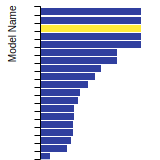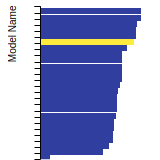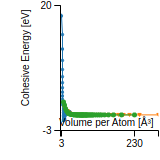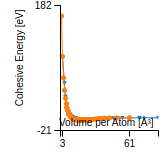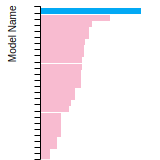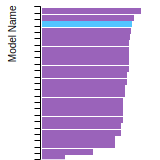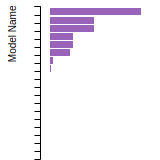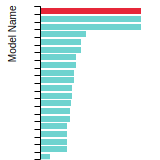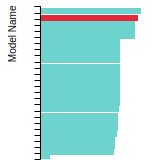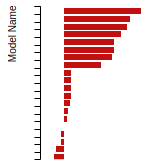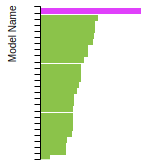Citations
This panel presents information regarding the papers that have cited the interatomic potential (IP) whose page you are on.
The OpenKIM machine learning based Deep Citation framework is used to determine whether the citing article actually used the IP in computations (denoted by "USED") or only provides it as a background citation (denoted by "NOT USED"). For more details on Deep Citation and how to work with this panel, click the documentation link at the top of the panel.
The word cloud to the right is generated from the abstracts of IP principle source(s) (given below in "How to Cite") and the citing articles that were determined to have used the IP in order to provide users with a quick sense of the types of physical phenomena to which this IP is applied.
The bar chart shows the number of articles that cited the IP per year. Each bar is divided into green (articles that USED the IP) and blue (articles that did NOT USE the IP).
Users are encouraged to correct Deep Citation errors in determination by clicking the speech icon next to a citing article and providing updated information. This will be integrated into the next Deep Citation learning cycle, which occurs on a regular basis.
OpenKIM acknowledges the support of the Allen Institute for AI through the Semantic Scholar project for providing citation information and full text of articles when available, which are used to train the Deep Citation ML algorithm.
|
This panel provides information on past usage of this interatomic potential (IP) powered by the OpenKIM Deep Citation framework. The word cloud indicates typical applications of the potential. The bar chart shows citations per year of this IP (bars are divided into articles that used the IP (green) and those that did not (blue)). The complete list of articles that cited this IP is provided below along with the Deep Citation determination on usage. See the Deep Citation documentation for more information.

Help us to determine which of the papers that cite this potential actually used it to perform calculations. If you know, click the .
USED (high confidence) H. Min et al., “Modified Random Sequential Adsorption Model for Understanding Kinetics of Proteins Adsorption at a Liquid-Solid Interface.,” Langmuir : the ACS journal of surfaces and colloids. 2017. link Times cited: 8 Abstract: In this Article, we experimentally measure the adsorption ki… read moreAbstract: In this Article, we experimentally measure the adsorption kinetics of human serum albumin (HSA) on a hydrophobic hexadecanethiolated gold surface. We use micromachined quartz crystal resonators with fundamental frequency of 83 MHz to accomplish these measurements in real time. In this work, we focus on two key results: (i) asymptotic behavior of the sensor responses upon HSA adsorption and (ii) the jamming limit of adsorbed layer formed by both single-injection and multi-injection experiments with the same value of final concentration. We develop a new interface-depletion modified random sequential adsorption (RSA) model to elucidate the adsorption kinetics and the transport properties of the protein molecules. Analysis of the experimentally measured data shows that the results can be explained on the basis of the exponentially depleting interfacial layer RSA model. To better understand the origin of the formation of the interfacial depletion region where the supply of protein molecules is dramatically reduced, we performed a series of molecular dynamics (MD) simulations using the ReaxFF method. These simulations predict that the resulting adsorption of the protein molecules on the thiolated surface results in a specific orientation at the interface and the diffusion constant of the protein molecules in this layer is significantly reduced. This interplay between the surface adsorption rate and the reduced diffusion coefficient leads to the depletion of the protein molecules in the interfacial layer where the concentration of the protein molecules is much less than the bulk concentration and explains the observed slowdown of the HSA adsorption characteristics on a hydrophobic surface. read less USED (high confidence) A. Ulvestad et al., “In Situ 3D Imaging of Catalysis Induced Strain in Gold Nanoparticles.,” The journal of physical chemistry letters. 2016. link Times cited: 30 Abstract: Multielectron transfer processes are crucially important in … read moreAbstract: Multielectron transfer processes are crucially important in energy and biological science but require favorable catalysts to achieve fast kinetics. Nanostructuring catalysts can dramatically improve their properties, which can be difficult to understand due to strain- and size-dependent thermodynamics, the influence of defects, and substrate-dependent activities. Here, we report three-dimensional (3D) imaging of single gold nanoparticles during catalysis of ascorbic acid decomposition using Bragg coherent diffractive imaging (BCDI). Local strains were measured in single nanoparticles and modeled using reactive molecular dynamics (RMD) simulations and finite element analysis (FEA) simulations. RMD reveals the pathway for local strain generation in the gold lattice: chemisorption of hydroxyl ions. FEA reveals that the RMD results are transferable to the nanocrystal sizes studied in the experiment. Our study probes the strain-activity connection and opens a powerful avenue for theoretical and experimental studies of nanocrystal catalysis. read less USED (high confidence) L. Zhang, W. Wu, Y. Zhou, H. Ren, J. Dong, and H. Li, “Electronic transport properties of ultra-thin Ni and Ni-C nanowires.,” Physical chemistry chemical physics : PCCP. 2016. link Times cited: 4 Abstract: The structures and electronic transport properties of ultra-… read moreAbstract: The structures and electronic transport properties of ultra-thin Ni and Ni-C nanowires obtained from carbon nanotube (CNT) templates are theoretically investigated. C atoms tend to locate at the central positions of nanowires and are surrounded by Ni atoms. Spin polarization at the Fermi level is not responsible for the spin filtration of these nanowires. Increasing C concentration can improve the resistance of nanowires by abating the number of electronic transmission channels and the coupling of electron orbitals between Ni atoms. Moreover, with the increase of diameter, the conductance of these nanowires increases as well. This study is helpful for guiding the synthesis of nanowires with desired applications. read less USED (high confidence) S. Ali, V. Myasnichenko, and E. Neyts, “Size-dependent strain and surface energies of gold nanoclusters.,” Physical chemistry chemical physics : PCCP. 2016. link Times cited: 60 Abstract: Gold nanocluster properties exhibit unique size-dependence. … read moreAbstract: Gold nanocluster properties exhibit unique size-dependence. In this contribution, we employ reactive molecular dynamics simulations to calculate the size- and temperature-dependent surface energies, strain energies and atomic displacements for icosahedral, cuboctahedral, truncated octahedral and decahedral Au-nanoclusters. The calculations demonstrate that the surface energy decreases with increasing cluster size at 0 K but increases with size at higher temperatures. The calculated melting curves as a function of cluster size demonstrate the Gibbs-Thomson effect. Atomic displacements and strain are found to strongly depend on the cluster size and both are found to increase with increasing cluster size. These results are of importance for understanding the size- and temperature-dependent surface processes on gold nanoclusters. read less USED (high confidence) M. Berritta, D. Manrique, and C. Lambert, “Interplay between quantum interference and conformational fluctuations in single-molecule break junctions.,” Nanoscale. 2015. link Times cited: 18 Abstract: We theoretically explored the combined role of conformationa… read moreAbstract: We theoretically explored the combined role of conformational fluctuations and quantum interference in determining the electrical conductance of single-molecule break junctions. In particular we computed the conductance of a family of methylsulfide-functionalized trans-α,ω-diphenyloligoene molecules, with terminal phenyl rings containing meta or para linkages, for which (at least in the absence of fluctuations) destructive interference in the former is expected to decrease their electrical conductance compared with the latter. We compared the predictions of density functional theory (DFT), in which fluctuational effects are absent, with results for the conformationally-averaged conductance obtained from an ensemble of conformations obtained from classical molecular dynamics. We found that junctions formed from these molecules exhibit distinct transport regimes during junction evolution and the signatures of quantum interference in these molecules survive the effect of conformational fluctuations. Furthermore, the agreement between theory and experiment is significantly improved by including conformational averaging. read less USED (high confidence) P. Kaghazchi, D. Fantauzzi, J. Anton, and T. Jacob, “Nanoscale-faceting of metal surfaces induced by adsorbates.,” Physical chemistry chemical physics : PCCP. 2010. link Times cited: 9 Abstract: Using density functional theory and thermodynamic considerat… read moreAbstract: Using density functional theory and thermodynamic considerations, adsorbate-induced faceting of high-index metal surfaces such as Ir(210) and Re(112 1) has been studied. Focusing on these two systems we first discuss the adsorption behaviour of oxygen and nitrogen on the various surfaces relevant for the faceting, and afterwards use these energies to evaluate the stability of substrates and facets in the presence of oxygen and nitrogen. The faceting phase diagrams of Ir(210) and Re(112 1) show that both adsorbates enhance the anisotropy in surface free energy, finally causing nanofacets to become the thermodynamically favourable surface structure. We also generated analogous electrochemical phase diagrams for both surfaces in contact with an oxygen- or nitrogen-containing electrolyte and found that the same nanofacets should also become stable at positive electrode potentials. Thus, our calculations not only reproduce the experimentally observed surface faceting under UHV conditions, but also predict facet formation under electrochemical conditions. read less USED (low confidence) S. Saha, D. Bhadyopadhyay, and N. Choudhury, “Solvation Structure and Dynamics of Aqueous Solutions of Au^+ Ions: A Molecular Dynamics Simulation Study,” Journal of Solution Chemistry. 2023. link Times cited: 0 USED (low confidence) H. Haouas, L. E. Atouani, K. Sbiaai, and A. Hasnaoui, “Size and temperature effects on surface energy of Au and Fe nanoparticles from atomistic simulations,” Computational Materials Science. 2022. link Times cited: 1 USED (low confidence) S. Li, X. Yao, X. Wang, S.-Q. Tian, and Y. Zhang, “Reactive molecular dynamics simulation on degradation of aflatoxin B1 by cold atmospheric plasmas,” Innovative Food Science & Emerging Technologies. 2022. link Times cited: 8 USED (low confidence) J. Yang, W. Zhang, D. Hou, G. Zhang, and Q. Ding, “Structure, dynamics and mechanical properties evolution of calcium silicate hydrate induced by dehydration and dehydroxylation,” Construction and Building Materials. 2021. link Times cited: 14 USED (low confidence) S. Starikov, I. Gordeev, Y. Lysogorskiy, L. Kolotova, and S. Makarov, “Optimized interatomic potential for study of structure and phase transitions in Si-Au and Si-Al systems,” Computational Materials Science. 2020. link Times cited: 19 USED (low confidence) J. Zhang, J. Yang, D. Hou, and Q. Ding, “Molecular dynamics study on calcium aluminosilicate hydrate at elevated temperatures: Structure, dynamics and mechanical properties,” Materials Chemistry and Physics. 2019. link Times cited: 14 USED (low confidence) S. Monti, G. Barcaro, L. Sementa, V. Carravetta, and H. Ågren, “Characterization of the adsorption dynamics of trisodium citrate on gold in water solution,” RSC Advances. 2017. link Times cited: 26 Abstract: Molecular dynamics simulations (MDs) based on a reactive for… read moreAbstract: Molecular dynamics simulations (MDs) based on a reactive force field (ReaxFF) are carried out to investigate typical adsorption modes of trisodium citrate (CIT) on gold nanoparticles (AuNPs). All possible configurations of CIT on a model AuNP in solution are identified and the stabilizing role played by the adsorbate on the AuNP structure is disclosed by analyzing protonation state, dynamics and interactions of the molecules with the surrounding environment. A realistic scenario is created by sampling extensively the conformational space of citrate and by validating the simulation results against data extracted from the literature. Carboxyl moieties are found in contact with the gold substrate through one or both oxygens and Na+ ions are present in the adsorbed citrate layer. Citrate binding is relatively strong and its action as a chelator stabilizes surface reconstructions. The molecules have the tendency to self-assemble and form a stable cover, which is reinforced by adatoms. All the results are in perfect agreement with experimental observations and theoretical data. read less USED (low confidence) D. Bhandary, V. Valechi, M. Cordeiro, and J. Singh, “Janus Gold Nanoparticles from Nanodroplets of Alkyl Thiols: A Molecular Dynamics Study.,” Langmuir : the ACS journal of surfaces and colloids. 2017. link Times cited: 10 Abstract: Janus particles provide an asymmetry in structure, which can… read moreAbstract: Janus particles provide an asymmetry in structure, which can impart diverse functionalities leading to immense importance in various applications, ranging from targeted delivery to interfacial phenomena, including catalysis, electronics, and optics. In this work, we present results of a molecular dynamics study of the growth mechanism of coating on gold nanoparticles (AuNPs) from droplets of n-alkyl thiols with different chain lengths (C5 and C11) and terminal groups (CH3 and COOH). The effect of chain lengths and functional groups on the formation of a monolayer of alkyl thiols on AuNPs is investigated. A two-step mechanism, initiated by the binding of the droplet to the nanoparticle surface with a time constant on the order of ∼1 ns, followed by the diffusion-driven growth with a larger time constant (on the order of 100 ns), is shown to capture the growth dynamics of the monolayer. It is observed that the time required for complete wetting increases with an increase in the chain length. Moreover, the monolayer formation is slowed down in the presence of carboxyl groups because of strong hydrogen bonding. The kinetics of the n-alkyl thiols coating on the nanoparticles is found to be independent of the droplet size but carboxyl-terminated thiols spread more with increasing droplet size. Furthermore, different time constants for different chains and functional groups yield Janus coating when two droplets of alkyl thiols with different terminal groups are allowed to form monolayers on the nanoparticle. The Janus balance (β) for different combinations of alkyl thiols and nanoparticle sizes varies in the range of 0.42-0.71. read less USED (low confidence) X. Zhang et al., “Site Stability on Cobalt Nanoparticles: A Molecular Dynamics ReaxFF Reactive Force Field Study,” Journal of Physical Chemistry C. 2014. link Times cited: 31 Abstract: The stability of step-edge-type surface sites on cobalt nano… read moreAbstract: The stability of step-edge-type surface sites on cobalt nanoparticles is investigated for particles of increasing size of 1.8, 2.2, and 2.9 nm, that contain 321, 603, and 1157 atoms, respectively. The stability of surface configurations is probed by analyzing the kinetics of the disappearance of step-edge sites as a function of temperature using ReaxFF reactive force field molecular dynamics (MD) simulations. The MD simulations are based on a newly designed reactive force field. Two different activation energy regimes are identified. A low activation barrier of the order of 7 kJ/mol corresponds to single atom movement, which is independent of Co nanoparticle size. Higher activation energies (28, 37, and 22 kJ/mol for the three clusters, respectively) correspond to the shift of overlayer terraces. These concerted shifts appear to be sensitive to particle size, terrace size, and the structure of the facet. Step edges are more stable on larger particles. Shifting of the (111) surface layers leads to transfor... read less USED (low confidence) X. Liu, F. Wang, H. S. Park, and H. Wu, “Defecting controllability of bombarding graphene with different energetic atoms via reactive force field model,” Journal of Applied Physics. 2013. link Times cited: 29 Abstract: We study the bombardment of a suspended monolayer graphene s… read moreAbstract: We study the bombardment of a suspended monolayer graphene sheet via different energetic atoms via classical molecular dynamics based on the reactive force field (ReaxFF). We find that the probability, quality, and controllability of defects are mainly determined by the impact site, the properties of the incident atom, and the incident energy. Through comparison with density functional theory calculations, we demonstrate that defects and vacancies in graphene form only in regions of sufficiently high electron density. Furthermore, the quality of defects is influenced by the bond order of the incident atom-carbon bonds, where a higher bond order leads to lower probability of pristine defects (vacancies) but a higher probability of direct-substitution. Finally, the incident energy plays an important role on the evolution and final pattern of defects in graphene. Based on the probability, quality, and controllability analysis performed, we depict a full-range energy spectrum for atomic bombardment, where we ... read less USED (low confidence) K. Kleiner et al., “Multiscale Modeling of Au-Island Ripening on Au(100),” Advances in Physical Chemistry. 2011. link Times cited: 11 Abstract: We describe a multiscale modeling hierarchy for the particul… read moreAbstract: We describe a multiscale modeling hierarchy for the particular case of Au-island ripening on Au(100). Starting at the microscopic scale, density functional theory was used to investigate a limited number of self-diffusion processes on perfect and imperfect Au(100) surfaces. The obtained structural and energetic information served as basis for optimizing a reactive forcefield (here ReaxFF), which afterwards was used to address the mesoscopic scale. Reactive force field simulations were performed to investigate more diffusion possibilities at a lower computational cost but with similar accuracy. Finally, we reached the macroscale by means of kinetic Monte Carlo (kMC) simulations. The reaction rates for the reaction process database used in the kMC simulations were generated using the reactive force field. Using this strategy, we simulated nucleation, aggregation, and fluctuation processes for monoatomic high islands on Au(100) and modeled their equilibrium shape structures. Finally, by calculating the step line tension at different temperatures, we were able to make a direct comparison with available experimental data. read less USED (low confidence) X. Liu, “Defect-Induced Discontinuous Effects in Graphene Nanoribbon Under Torsion Loading,” Springer Theses. 2019. link Times cited: 0 NOT USED (low confidence) J. Tiihonen and H. Häkkinen, “Towards structural optimization of gold nanoclusters with quantum Monte Carlo.,” The Journal of chemical physics. 2023. link Times cited: 0 Abstract: We study the prospects of using quantum Monte Carlo techniqu… read moreAbstract: We study the prospects of using quantum Monte Carlo techniques (QMC) to optimize the electronic wavefunctions and atomic geometries of gold compounds. Complex gold nanoclusters are widely studied for diverse biochemical applications, but the dynamic correlation and relativistic effects in gold set the bar high for reliable, predictive simulation methods. Here we study selected ground state properties of few-atom gold clusters by using density functional theory (DFT) and various implementations of the variational Monte Carlo (VMC) and diffusion Monte Carlo. We show that the QMC methods mitigate the exchange-correlation (XC) approximation made in the DFT approach: the average QMC results are more accurate and significantly more consistent than corresponding DFT results based on different XC functionals. Furthermore, we use demonstrate structural optimization of selected thiolated gold clusters with between 1 and 3 gold atoms using VMC forces. The optimization workflow is demonstrably consistent, robust, and its computational cost scales with nb, where b < 3 and n is the system size. We discuss the implications of these results while laying out steps for further developments. read less NOT USED (low confidence) S. Li et al., “Atomic-scale simulations of the deoxynivalenol degradation induced by reactive oxygen plasma species.,” Food research international. 2022. link Times cited: 2 NOT USED (low confidence) P. Niedziałkowski et al., “Deciphering the Molecular Mechanism of Substrate-Induced Assembly of Gold Nanocube Arrays toward an Accelerated Electrocatalytic Effect Employing Heterogeneous Diffusion Field Confinement,” Langmuir. 2022. link Times cited: 5 Abstract: The complex electrocatalytic performance of gold nanocubes (… read moreAbstract: The complex electrocatalytic performance of gold nanocubes (AuNCs) is the focus of this work. The faceted shapes of AuNCs and the individual assembly processes at the electrode surfaces define the heterogeneous conditions for the purpose of electrocatalytic processes. Topographic and electron imaging demonstrated slightly rounded AuNC (average of 38 nm) assemblies with sizes of ≤1 μm, where the dominating patterns are (111) and (200) crystallographic planes. The AuNCs significantly impact the electrochemical performance of the investigated electrode [indium–tin oxide (ITO), glassy carbon (GC), and bulk gold] systems driven by surface electrons promoting the catalytic effect. Cyclic voltammetry in combination with scanning electrochemical microscopy allowed us to decipher the molecular mechanism of substrate-induced electrostatic assembly of gold nanocube arrays, revealing that the accelerated electrocatalytic effect should be attributed to the confinement of the heterogeneous diffusion fields with tremendous electrochemically active surface area variations. AuNC drop-casting at ITO, GC, and Au led to various mechanisms of heterogeneous charge transfer; only in the case of GC did the decoration significantly increase the electrochemically active surface area (EASA) and ferrocyanide redox kinetics. For ITO and Au substrates, AuNC drop-casting decreases system dimensionality rather than increasing the EASA, where Au–Au self-diffusion was also observed. Interactions of the gold, ITO, and GC surfaces with themselves and with surfactant CTAB and ferrocyanide molecules were investigated using density functional theory. read less NOT USED (low confidence) C. Dulong, B. Madebène, S. Monti, and J. Richardi, “Optimization of a new reactive force field for silver-based materials.,” Journal of chemical theory and computation. 2020. link Times cited: 3 Abstract: A new reactive force field based on the ReaxFF formalism is … read moreAbstract: A new reactive force field based on the ReaxFF formalism is effectively parametrized against an extended training set of quantum chemistry data (containing more than 120 different structures) to describe accurately silver- and silver-thiolate systems. The results obtained with this novel representation demonstrate that the novel ReaxFF paradigm is a powerful methodology to reproduce more appropriately average geometric and energetic properties of metal clusters and slabs when compared to the earlier ReaxFF parametrizations dealing with silver and gold. ReaxFF cannot describe adequately specific geometrical features such as the observed shorter distances between the under-coordinated atoms at the cluster edges. Geometric and energetic properties of thiolates adsorbed on a silver Ag20 pyramid are correctly represented by the new ReaxFF and compared with results for gold. The simulation of self-assembled monolayers of thiolates on a silver (111) surface does not indicate the formation of staples in contrast to the results for gold-thiolate systems. read less NOT USED (low confidence) I. Shuttleworth, “Development of the ReaxFF Reactive Force-Field Description of Gold Oxides,” Journal of Physical Chemistry C. 2017. link Times cited: 2 Abstract: For the investigation of the interaction between oxygen and … read moreAbstract: For the investigation of the interaction between oxygen and gold over length- and time-scales which reflect the operation of real catalysts, the reactive force-field (ReaxFF) description of the O/Au interaction has been developed. This development has been achieved in two stages: first, by fitting the parameters of the potential against an extensive set of both bulk and surface Au, O2, and gold oxides derived from full quantum mechanical simulations. The resulting potential has been used in a series of molecular dynamics (MD) simulations emulating the interaction between oxygen and the Au(111), the missing-row (1 × 2)-mr-Au(110), pairing-row (1 × 3)-pr-Au(110), trenched (1 × 3)-tr-Au(110), and added-row (2 × 1)-ar-Au(100) surfaces. These simulations have shown, in agreement with experimental studies, that oxygen diffusion from the surface to the bulk is heavily limited and generally only possible when thermal processing has started melting the Au substrate. Grand canonical Monte Carlo/molecular dynamics (... read less NOT USED (low confidence) D. Depew and J. Wang, “Density Functional Theory Investigations on Bulk Iridium Structures for ReaxFF Catalysis Parameterization.” 2016. link Times cited: 0 NOT USED (low confidence) S. Monti, V. Carravetta, and H. Ågren, “Simulation of Gold Functionalization with Cysteine by Reactive Molecular Dynamics.,” The journal of physical chemistry letters. 2016. link Times cited: 41 Abstract: The anchoring mechanism of cysteine to gold in water solutio… read moreAbstract: The anchoring mechanism of cysteine to gold in water solution is characterized in detail by means of a combination of quantum chemistry (QC) and reactive classical molecular dynamics (RC-MD) calculations. A possible adsorption-reaction route is proposed, through RC-MD simulations based on a modified version of the protein reactive force field (ReaxFF), in which gold-protein interactions have been included after accurate parametrization at the QC level. The computational results confirm recent experimental findings regarding the mechanism as a two-step binding, namely, a slow physisorption followed by a fast chemisorption. The reaction barriers are estimated through the nudged elastic band approach and checked by QC calculations. Surface reconstructions, induced by the strong adsorption of the molecule, are identified, and their role, as further adsorbate stabilizers, is properly disclosed. The satisfactory agreement with QC data and experiments confirm the reliability of the simulations and the unique opportunity they provide to follow locally molecule adsorption on selected materials. read less NOT USED (low confidence) A. M. Raymunt, R. T. Bell, M. Thompson, and P. Clancy, “Effect of Laser Annealing on the Structure of Amorphous Porous SiCOH Materials,” Journal of Physical Chemistry C. 2015. link Times cited: 5 Abstract: The inherent trade-off of porosity and mechanical properties… read moreAbstract: The inherent trade-off of porosity and mechanical properties in ultralow dielectric constant SiCOH materials is a critical challenge in semiconductor processing. Numerous postdeposition processes have been studied to achieve simultaneous low-k materials with adequate mechanical rigidity, including thermal annealing. Typically, these thermal anneals are characterized by times on the order of seconds to minutes at relatively low temperatures (below 500 °C). In this work, we report on potential advantages of submillisecond time frame anneals at extreme temperatures up to 1200 °C. The effects of such processing on the structure of ultralow-k materials were studied using molecular dynamics computer simulations employing a force field that facilitates the determination of bond rearrangements, coupled with direct experimental measurements during CO2 laser-induced spike annealing. Results show structural evolution with increasing temperature leading to densification of the SiOx network, reduction in the concentra... read less NOT USED (low confidence) T. Liang et al., “Reactive Potentials for Advanced Atomistic Simulations,” Materials Research-ibero-american Journal of Materials. 2013. link Times cited: 180 Abstract: This article reviews recent advances in the development of r… read moreAbstract: This article reviews recent advances in the development of reactive empirical force fields or potentials. In particular, we compare two widely used reactive potentials with variable-charge schemes that are desirable for multicomponent or multifunctional systems: the ReaxFF (reactive force field) and charge-optimized many-body (COMB) potentials. Several applications of these approaches in atomistic simulations that involve metal-based heterogeneous systems are also discussed. read less NOT USED (low confidence) H. Heinz, T.-J. Lin, R. K. Mishra, and F. Emami, “Thermodynamically consistent force fields for the assembly of inorganic, organic, and biological nanostructures: the INTERFACE force field.,” Langmuir : the ACS journal of surfaces and colloids. 2013. link Times cited: 635 Abstract: The complexity of the molecular recognition and assembly of … read moreAbstract: The complexity of the molecular recognition and assembly of biotic-abiotic interfaces on a scale of 1 to 1000 nm can be understood more effectively using simulation tools along with laboratory instrumentation. We discuss the current capabilities and limitations of atomistic force fields and explain a strategy to obtain dependable parameters for inorganic compounds that has been developed and tested over the past decade. Parameter developments include several silicates, aluminates, metals, oxides, sulfates, and apatites that are summarized in what we call the INTERFACE force field. The INTERFACE force field operates as an extension of common harmonic force fields (PCFF, COMPASS, CHARMM, AMBER, GROMACS, and OPLS-AA) by employing the same functional form and combination rules to enable simulations of inorganic-organic and inorganic-biomolecular interfaces. The parametrization builds on an in-depth understanding of physical-chemical properties on the atomic scale to assign each parameter, especially atomic charges and van der Waals constants, as well as on the validation of macroscale physical-chemical properties for each compound in comparison to measurements. The approach eliminates large discrepancies between computed and measured bulk and surface properties of up to 2 orders of magnitude using other parametrization protocols and increases the transferability of the parameters by introducing thermodynamic consistency. As a result, a wide range of properties can be computed in quantitative agreement with experiment, including densities, surface energies, solid-water interface tensions, anisotropies of interfacial energies of different crystal facets, adsorption energies of biomolecules, and thermal and mechanical properties. Applications include insight into the assembly of inorganic-organic multiphase materials, the recognition of inorganic facets by biomolecules, growth and shape preferences of nanocrystals and nanoparticles, as well as thermal transitions and nanomechanics. Limitations and opportunities for further development are also described. read less NOT USED (low confidence) L. Morrissey, S. M. Handrigan, and S. Nakhla, “Discrepancies in the mechanical properties of gold nanowires: The importance of potential type and equilibration method,” Computational Materials Science. 2020. link Times cited: 6 NOT USED (high confidence) C. D. Griego et al., “Computationally Guided Searches for Efficient Catalysts through Chemical/Materials Space: Progress and Outlook,” Journal of Physical Chemistry C. 2021. link Times cited: 2 Abstract: Computational quantum chemistry promises to help guide the d… read moreAbstract: Computational quantum chemistry promises to help guide the design of catalysts that are more sustainable and economical. This Feature Article gives a tutorial overview of how our group accounts for... read less NOT USED (high confidence) R. K. Shayakhmetova and E. Khamitov, “ReaxFF Molecular Dynamics Simulation of the Cracking of Components of Vacuum Gasoil in the Presence of a Nickel Nanocluster,” Russian Journal of Physical Chemistry A. 2021. link Times cited: 0 NOT USED (high confidence) T. Loeffler, S. Manna, T. Patra, H. Chan, B. Narayanan, and S. Sankaranarayanan, “Active Learning A Neural Network Model For Gold Clusters & Bulk From Sparse First Principles Training Data,” ChemCatChem. 2020. link Times cited: 15 Abstract: Small metal clusters are of fundamental scientific interest … read moreAbstract: Small metal clusters are of fundamental scientific interest and of tremendous significance in catalysis. These nanoscale clusters display diverse geometries and structural motifs depending on the cluster size; a knowledge of this size‐dependent structural motifs and their dynamical evolution has been of longstanding interest. Given the high computational cost of first‐principles calculations, molecular modeling and atomistic simulations such as molecular dynamics (MD) has proven to be an important complementary tool to aid this understanding. Classical MD typically employ predefined functional forms which limits their ability to capture such complex size‐dependent structural and dynamical transformation. Neural Network (NN) based potentials represent flexible alternatives and in principle, well‐trained NN potentials can provide high level of flexibility, transferability and accuracy on‐par with the reference model used for training. A major challenge, however, is that NN models are interpolative and requires large quantities ( ∼104 or greater) of training data to ensure that the model adequately samples the energy landscape both near and far‐from‐equilibrium. A highly desirable goal is minimize the number of training data, especially if the underlying reference model is first‐principles based and hence expensive. Here, we introduce an active learning (AL) scheme that trains a NN model on‐the‐fly with minimal amount of first‐principles based training data. Our AL workflow is initiated with a sparse training dataset ( ∼ 1 to 5 data points) and is updated on‐the‐fly via a Nested Ensemble Monte Carlo scheme that iteratively queries the energy landscape in regions of failure and updates the training pool to improve the network performance. Using a representative system of gold clusters, we demonstrate that our AL workflow can train a NN with ∼ 500 total reference calculations. Using an extensive DFT test set of ∼1100 configurations, we show that our AL‐NN is able to accurately predict both the DFT energies and the forces for clusters of a myriad of different sizes. Our NN predictions are within 30 meV/atom and 40 meV/Å of the reference DFT calculations. Moreover, our AL‐NN model also adequately captures the various size‐dependent structural and dynamical properties of gold clusters in excellent agreement with DFT calculations and available experiments. We finally show that our AL‐NN model also captures bulk properties reasonably well, even though they were not included in the training data. read less NOT USED (high confidence) A. C. D. López and E. Pehlke, “Initial steps toward Auad island nucleation on a c(2 × 2)-Cl Au(001) surface investigated by DFT.,” The Journal of chemical physics. 2020. link Times cited: 1 Abstract: Density functional theory calculations are reported that elu… read moreAbstract: Density functional theory calculations are reported that elucidate the initial steps toward Au ad-island nucleation on c(2 × 2)-Cl covered Au(001) surfaces, which is relevant for Au electrodeposition in Cl- containing electrolytes. The atomic geometry of (Auad)n adatom structures for n ≤ 4, as well as their stability as a function of Cl chemical potential, has been determined. The electrolyte, however, has not been accounted for in the computation. We find a weakly bonded (AuadCl2)-chain as the most stable structure in the case of Cl chemical potentials such that Cl vacancies are suppressed. In the range of Cl chemical potential, where Cl vacancies occur in equilibrium and bind to an (modified) Auad induced ad-structure, the formation of a dimer from two monomers is accompanied by an energy gain between 0.06 and 0.23 eV. For Auad trimer and tetramer formation, the calculations suggest a similar tendency. This suggests that on c(2 × 2)-Cl covered Au(001) surfaces, the Au ad-island nucleation is supported by the presence of vacancies in the Cl adlayer. read less NOT USED (high confidence) H. S. Huang, L. Ai, A. V. van Duin, M. Chen, and Y. Lü, “ReaxFF reactive force field for molecular dynamics simulations of liquid Cu and Zr metals.,” The Journal of chemical physics. 2019. link Times cited: 10 Abstract: We develop a ReaxFF reactive force field used for the molecu… read moreAbstract: We develop a ReaxFF reactive force field used for the molecular dynamics simulations of thermophysical properties of liquid Cu and Zr metals. The ReaxFF parameters are optimized by fitting to the first-principles density-functional calculations on the equations of state for bulk crystal structures and surface energies. To validate the force field, we compare the ReaxFF results with those from experiments and embedded-atom-method (EAM) potentials. We demonstrate that the present ReaxFF force field well represents structural characteristics and diffusion behaviors of elemental Cu and Zr up to high-temperature liquid regions. It reasonably reproduces the thermodynamic processes associated with crystal-liquid interface. In particular, the equilibrium melting temperatures show better agreement with experimental measurements than the results from EAM potentials. The ReaxFF reactive force field method exhibits a good transferability to the nonreactive processes of liquid systems. read less NOT USED (high confidence) A. Antony et al., “Charge optimized many body (COMB) potentials for Pt and Au,” Journal of Physics: Condensed Matter. 2017. link Times cited: 12 Abstract: Interatomic potentials for Pt and Au are developed within th… read moreAbstract: Interatomic potentials for Pt and Au are developed within the third generation charge optimized many-body (COMB3) formalism. The potentials are capable of reproducing phase order, lattice constants, and elastic constants of Pt and Au systems as experimentally measured or calculated by density functional theory. We also fit defect formation energies, surface energies and stacking fault energies for Pt and Au metals. The resulting potentials are used to map a 2D contour of the gamma surface and simulate the tensile test of 16-grain polycrystalline Pt and Au structures at 300 K. The stress–strain behaviour is investigated and the primary slip systems {1 1 1}〈1 1¯ 0〉 are identified. In addition, we perform high temperature (1800 K for Au and 2300 K for Pt) molecular dynamics simulations of 30 nm Pt and Au truncated octahedron nanoparticles and examine morphological changes of each particle. We further calculate the activation energy barrier for surface diffusion during simulations of several nanoseconds and report energies of 0.62±0.16 eV for Pt and 1.44±0.06 eV for Au. This initial parameterization and application of the Pt and Au potentials demonstrates a starting point for the extension of these potentials to multicomponent systems within the COMB3 framework. read less NOT USED (high confidence) J. R. Boes, M. C. Groenenboom, J. Keith, and J. Kitchin, “Neural network and ReaxFF comparison for Au properties,” International Journal of Quantum Chemistry. 2016. link Times cited: 64 Abstract: We have studied how ReaxFF and Behler–Parrinello neural netw… read moreAbstract: We have studied how ReaxFF and Behler–Parrinello neural network (BPNN) atomistic potentials should be trained to be accurate and tractable across multiple structural regimes of Au as a representative example of a single-component material. We trained these potentials using subsets of 9,972 Kohn-Sham density functional theory calculations and then validated their predictions against the untrained data. Our best ReaxFF potential was trained from 848 data points and could reliably predict surface and bulk data; however, it was substantially less accurate for molecular clusters of 126 atoms or fewer. Training the ReaxFF potential to more data also resulted in overfitting and lower accuracy. In contrast, BPNN could be fit to 9,734 calculations, and this potential performed comparably or better than ReaxFF across all regimes. However, the BPNN potential in this implementation brings significantly higher computational cost. © 2016 Wiley Periodicals, Inc. read less NOT USED (high confidence) S. Monti, V. Carravetta, and H. Ågren, “Decoration of gold nanoparticles with cysteine in solution: reactive molecular dynamics simulations.,” Nanoscale. 2016. link Times cited: 19 Abstract: The dynamics of gold nanoparticle functionalization by means… read moreAbstract: The dynamics of gold nanoparticle functionalization by means of adsorption of cysteine molecules in water solution is simulated through classical reactive molecular dynamics simulations based on an accurately parametrized force field. The adsorption modes of the molecules are characterized in detail disclosing the nature of the cysteine-gold interactions and the stability of the final material. The simulation results agree satisfactorily with recent experimental and theoretical data and confirm previous findings for a similar system. The covalent attachments of the molecules to the gold support are all slow physisorptions followed by fast chemisorptions. However, a great variety of binding arrangements can be observed. Interactions with the adsorbate caused surface modulations in terms of adatoms and dislocations which contributed to strengthen the cysteine adsorption. read less NOT USED (high confidence) X. Li, V. Carravetta, C. Li, S. Monti, Ž. Rinkevičius, and H. Ågren, “Optical Properties of Gold Nanoclusters Functionalized with a Small Organic Compound: Modeling by an Integrated Quantum-Classical Approach.,” Journal of chemical theory and computation. 2016. link Times cited: 7 Abstract: Motivated by the growing importance of organometallic nanost… read moreAbstract: Motivated by the growing importance of organometallic nanostructured materials and nanoparticles as microscopic devices for diagnostic and sensing applications, and by the recent considerable development in the simulation of such materials, we here choose a prototype system - para-nitroaniline (pNA) on gold nanoparticles - to demonstrate effective strategies for designing metal nanoparticles with organic conjugates from fundamental principles. We investigated the motion, adsorption mode, and physical chemistry properties of gold-pNA particles, increasing in size, through classical molecular dynamics (MD) simulations in connection with quantum chemistry (QC) calculations. We apply the quantum mechanics-capacitance molecular mechanics method [Z. Rinkevicius et al. J. Chem. Theory Comput. 2014, 10, 989] for calculations of the properties of the conjugate nanoparticles, where time dependent density functional theory is used for the QM part and a capacitance-polarizability parametrization of the MM part, where induced dipoles and charges by metallic charge transfer are considered. Dispersion and short-range repulsion forces are included as well. The scheme is applied to one- and two-photon absorption of gold-pNA clusters increasing in size toward the nanometer scale. Charge imaging of the surface introduces red-shifts both because of altered excitation energy dependence and variation of the relative intensity of the inherent states making up for the total band profile. For the smaller nanoparticles the difference in the crystal facets are important for the spectral outcome which is also influenced by the surrounding MM environment. read less NOT USED (high confidence) Y. Han, D. D. Jiang, J. Zhang, W. Li, Z. Gan, and J. Gu, “Development, applications and challenges of ReaxFF reactive force field in molecular simulations,” Frontiers of Chemical Science and Engineering. 2016. link Times cited: 87 NOT USED (high confidence) E. Pohjolainen, X. Chen, S. Malola, G. Groenhof, and H. Häkkinen, “A Unified AMBER-Compatible Molecular Mechanics Force Field for Thiolate-Protected Gold Nanoclusters.,” Journal of chemical theory and computation. 2016. link Times cited: 62 Abstract: We present transferable AMBER-compatible force field paramet… read moreAbstract: We present transferable AMBER-compatible force field parameters for thiolate-protected gold nanoclusters. Five different sized clusters containing both organo-soluble and water-soluble thiolate ligands served as test systems in MD simulations, and parameters were validated against DFT and experimental results. The cluster geometries remain intact during the MD simulations in various solvents, and structural fluctuations and energetics showed agreement with DFT calculations. Experimental diffusion coefficients and crystal structures were also reproduced with sufficient accuracy. The presented parameter set contains the minimum number of cluster-specific parameters enabling the use of these parameters for several different gold nanoclusters. The parameterization of ligands can also be extended to different types of ligands. read less NOT USED (high confidence) B. Narayanan et al., “Describing the Diverse Geometries of Gold from Nanoclusters to Bulk—A First-Principles-Based Hybrid Bond-Order Potential,” Journal of Physical Chemistry C. 2015. link Times cited: 27 Abstract: Molecular dynamics simulations using empirical force fields … read moreAbstract: Molecular dynamics simulations using empirical force fields (EFFs) are crucial for gaining fundamental insights into atomic structure and long time scale dynamics of Au nanoclusters with far-reaching applications in energy and devices. This approach is thwarted by the failure of currently available EFFs in describing the size-dependent dimensionality and diverse geometries exhibited by Au clusters (e.g., planar structures, hollow cages, tubes, pyramids, space-filled structures). Here, we mitigate this issue by introducing a new hybrid bond-order potential (HyBOP), which accounts for (a) short-range interactions via Tersoff-type BOP terms that accurately treat bond directionality and (b) long-range dispersion effects by a scaled Lennard–Jones term whose contribution depends on the local atomic density. We optimized the independent parameters for our HyBOP using a global optimization scheme driven by genetic algorithms. Moreover, to ensure good transferability of these parameters across different length sca... read less NOT USED (high confidence) B. Narayanan, S. A. Deshmukh, S. Sankaranarayanan, and S. Ramanathan, “Strong correlations between structural order and passive state at water–copper oxide interfaces,” Electrochimica Acta. 2015. link Times cited: 9 NOT USED (high confidence) D. Thompson et al., “Formation Mechanism of Metal–Molecule–Metal Junctions: Molecule-Assisted Migration on Metal Defects,” Journal of Physical Chemistry C. 2015. link Times cited: 14 Abstract: Activation energies, Ea, measured from molecular exchange ex… read moreAbstract: Activation energies, Ea, measured from molecular exchange experiments are combined with atomic-scale calculations to describe the migration of bare Au atoms and Au–alkanethiolate species on gold nanoparticle surfaces during ligand exchange for the creation of metal–molecule–metal junctions. It is well-known that Au atoms and alkanethiol–Au species can diffuse on gold with sub-1 eV barriers, and surface restructuring is crucial for self-assembled monolayer (SAM) formation for interlinking nanoparticles and in contacting nanoparticles to electrodes. In the present work, computer simulations reveal that naturally occurring ridges and adlayers on Au(111) are etched and resculpted by migration of alkanethiolate–Au species toward high coordination kink sites at surface step edges. The calculated energy barrier, Eb, for diffusion via step edges is 0.4–0.7 eV, close to the experimentally measured Ea of 0.5–0.7 eV. By contrast, putative migration from isolated nine-coordinated terrace sites and complete Au unbindi... read less NOT USED (high confidence) J. M. Cabrera-Trujillo, J. M. Montejano-Carrizales, F. Aguilera-Granja, and A. Posada-Amarillas, “Theoretical study of the thermally induced structural fluctuations in sub-nanometre size gold clusters,” The European Physical Journal D. 2015. link Times cited: 7 NOT USED (high confidence) D. Fantauzzi, J. Bandlow, L. Sabo, J. Mueller, A. V. van Duin, and T. Jacob, “Development of a ReaxFF potential for Pt-O systems describing the energetics and dynamics of Pt-oxide formation.,” Physical chemistry chemical physics : PCCP. 2014. link Times cited: 53 Abstract: ReaxFF force field parameters describing Pt-Pt and Pt-O inte… read moreAbstract: ReaxFF force field parameters describing Pt-Pt and Pt-O interactions have been developed and tested. The Pt-Pt parameters are shown to accurately account for the chemical nature, atomic structures and other materials properties of bulk platinum phases, low and high-index platinum surfaces and nanoclusters. The Pt-O parameters reliably describe bulk platinum oxides, as well as oxygen adsorption and oxide formation on Pt(111) terraces and the {111} and {100} steps connecting them. Good agreement between the force field and both density functional theory (DFT) calculations and experimental observations is demonstrated in the relative surface free energies of high symmetry Pt-O surface phases as a function of the oxygen chemical potential, making ReaxFF an ideal tool for more detailed investigations of more complex Pt-O surface structures. Validation for its application to studies of the kinetics and dynamics of surface oxide formation in the context of either molecular dynamics (MD) or Monte Carlo simulations are provided in part by a two-part investigation of oxygen diffusion on Pt(111), in which nudged elastic band (NEB) calculations and MD simulations are used to characterize diffusion processes and to determine the relevant diffusion coefficients and barriers. Finally, the power of the ReaxFF reactive force field approach in addressing surface structures well beyond the reach of routine DFT calculations is exhibited in a brief proof-of-concept study of oxygen adsorbate displacement within ordered overlayers. read less NOT USED (high confidence) H. Larsson, A. Duin, and B. Hartke, “Global optimization of parameters in the reactive force field ReaxFF for SiOH,” Journal of Computational Chemistry. 2013. link Times cited: 78 Abstract: We have used unbiased global optimization to fit a reactive … read moreAbstract: We have used unbiased global optimization to fit a reactive force field to a given set of reference data. Specifically, we have employed genetic algorithms (GA) to fit ReaxFF to SiOH data, using an in‐house GA code that is parallelized across reference data items via the message‐passing interface (MPI). Details of GA tuning turn‐ed out to be far less important for global optimization efficiency than using suitable ranges within which the parameters are varied. To establish these ranges, either prior knowledge can be used or successive stages of GA optimizations, each building upon the best parameter vectors and ranges found in the previous stage. We have finally arrive‐ed at optimized force fields with smaller error measures than those published previously. Hence, this optimization approach will contribute to converting force‐field fitting from a specialist task to an everyday commodity, even for the more difficult case of reactive force fields. © 2013 Wiley Periodicals, Inc. read less NOT USED (high confidence) O. Verners, Y. Shin, and A. Duin, “Molecular dynamics simulation of Al grain mixing in Fe/Ni matrices and its influence on oxidation,” Journal of Applied Physics. 2013. link Times cited: 1 Abstract: AlxNiyFe(1−x−y) alloys are structural materials with potenti… read moreAbstract: AlxNiyFe(1−x−y) alloys are structural materials with potential application in high-temperature oxidizing environments. These materials are of specific interest as they have the ability to develop an oxidation resistant surface layer. To study diffusion and oxidation processes related to this surface layer formation, the mixing behavior of different sized Al grains in pure Ni and Fe matrices, with approximate grain/matrix atom ratio of 1:3, at temperatures above and below the structure melting point, was studied using ReaxFF-based molecular dynamics simulations. The simulations have been carried out at constant pressure, with temperatures being stepwise ramped over the range of 300-3000 K. For the Ni matrix, our results indicated lower chemical strain energy for Al in the mixed alloy and completion of mixing at a lower temperature for the Fe matrix. These results confirm that the Al-Ni alloy is energetically more stable than the Al-Fe alloy, which is in agreement with experiment. Further, larger Al grains ... read less NOT USED (high confidence) E. Iype, M. Hütter, A. Jansen, S. S. Nedea, and C. Rindt, “Parameterization of a reactive force field using a Monte Carlo algorithm,” Journal of Computational Chemistry. 2013. link Times cited: 79 Abstract: Parameterization of a molecular dynamics force field is esse… read moreAbstract: Parameterization of a molecular dynamics force field is essential in realistically modeling the physicochemical processes involved in a molecular system. This step is often challenging when the equations involved in describing the force field are complicated as well as when the parameters are mostly empirical. ReaxFF is one such reactive force field which uses hundreds of parameters to describe the interactions between atoms. The optimization of the parameters in ReaxFF is done such that the properties predicted by ReaxFF matches with a set of quantum chemical or experimental data. Usually, the optimization of the parameters is done by an inefficient single‐parameter parabolic‐search algorithm. In this study, we use a robust metropolis Monte‐Carlo algorithm with simulated annealing to search for the optimum parameters for the ReaxFF force field in a high‐dimensional parameter space. The optimization is done against a set of quantum chemical data for MgSO4 hydrates. The optimized force field reproduced the chemical structures, the equations of state, and the water binding curves of MgSO4 hydrates. The transferability test of the ReaxFF force field shows the extend of transferability for a particular molecular system. This study points out that the ReaxFF force field is not indefinitely transferable. © 2013 Wiley Periodicals, Inc. read less NOT USED (high confidence) L. Wright, P. Rodger, S. Corni, and T. Walsh, “GolP-CHARMM: First-Principles Based Force Fields for the Interaction of Proteins with Au(111) and Au(100).,” Journal of chemical theory and computation. 2013. link Times cited: 202 Abstract: Computational simulation of peptide adsorption at the aqueou… read moreAbstract: Computational simulation of peptide adsorption at the aqueous gold interface is key to advancing the development of many applications based on gold nanoparticles, ranging from nanomedical devices to smart biomimetic materials. Here, we present a force field, GolP-CHARMM, designed to capture peptide adsorption at both the aqueous Au(111) and Au(100) interfaces. The force field, compatible with the bio-organic force field CHARMM, is parametrized using a combination of experimental and first-principles data. Like its predecessor, GolP (Iori, F.; et al. J. Comput. Chem.2009, 30, 1465), this force field contains terms to describe the dynamic polarization of gold atoms, chemisorbing species, and the interaction between sp(2) hybridized carbon atoms and gold. A systematic study of small molecule adsorption at both surfaces using the vdW-DF functional (Dion, M.; et al. Phys. Rev. Lett.2004, 92, 246401-1. Thonhauser, T.; et al. Phys. Rev. B2007, 76, 125112) is carried out to fit and test force field parameters and also, for the first time, gives unique insights into facet selectivity of gold binding in vacuo. Energetic and spatial trends observed in our DFT calculations are reproduced by the force field under the same conditions. Finally, we use the new force field to calculate adsorption energies, under aqueous conditions, for a representative set of amino acids. These data are found to agree with experimental findings. read less NOT USED (high confidence) Y. Shin, H. Kwak, C. Zou, A. Vasenkov, and A. V. van Duin, “Development and validation of a ReaxFF reactive force field for Fe/Al/Ni alloys: molecular dynamics study of elastic constants, diffusion, and segregation.,” The journal of physical chemistry. A. 2012. link Times cited: 59 Abstract: We have developed a ReaxFF force field for Fe/Al/Ni binary a… read moreAbstract: We have developed a ReaxFF force field for Fe/Al/Ni binary alloys based on quantum mechanical (QM) calculations. In addition to the various bulk phases of the binary alloys, the (100), (110) and (111) surface energies and adatom binding energies were included in the training set for the force field parametrization of the Fe/Al/Ni binary alloys. To validate these optimized force fields, we studied (i) elastic constants of the binary alloys at finite temperatures, (ii) diffusivity of alloy components in Al/Ni alloy, and (iii) segregation on the binary alloy surfaces. First, we calculated linear elastic constants of FeAl, FeNi(3), and Ni(3)Al in the temperature range 300 to 1100 K. The temperature dependences of the elastic constants of these three alloys, showing a decrease in C(11), C(12), and C(44) as temperature increases, were in good agreement with the experimental results. We also performed ReaxFF molecular dynamics (MD) simulations for Al or Ni diffusion in the system modeled as Al/Ni mixed layers with the linear composition gradients. At 1000 K, Al diffusivity at the pure Al end was 2 orders of magnitude larger than that in the Al trace layers, probably explaining the nature of different diffusion behavior between molten metals and alloys. However, the diffusivity of Ni at the pure Ni end was only slightly larger than that in the Ni trace layers at the system temperature much lower than the melting temperature of Ni. Third, we investigated the surface segregation in L1(2)-Fe(3)Al, Fe(3)Ni, and Ni(3)Al clusters at high temperature (2500 K). From the analysis of composition distribution of the alloy components from the bulk to the surface layer, it was found that the degree of segregation depended on the chemical composition of the alloy. Al surface segregation occurred most strongly in Fe(3)Al, whereas it occurred most weakly in Ni(3)Al. These results may support the segregation mechanism that surface segregation results from the interplay between the energetic stability of the ordered bulk phase and the surface reconstruction. In addition, the surface segregation induced the depletion layers of segregating metal species (Al in Fe(3)Al and Ni(3)Al, and Ni in Fe(3)Ni) next to the segregation layers. These simulation results qualitatively agreed with early experimental observations of segregation in Fe/Al/Ni binary alloys. read less NOT USED (high confidence) M. Backman, N. Juslin, and K. Nordlund, “Bond order potential for gold,” The European Physical Journal B. 2012. link Times cited: 11 NOT USED (high confidence) K. Farah, F. Müller-Plathe, and M. Böhm, “Classical reactive molecular dynamics implementations: state of the art.,” Chemphyschem : a European journal of chemical physics and physical chemistry. 2012. link Times cited: 71 Abstract: Reactive molecular dynamics (RMD) implementations equipped w… read moreAbstract: Reactive molecular dynamics (RMD) implementations equipped with force field approaches to simulate both the time evolution as well as chemical reactions of a broad class of materials are reviewed herein. We subdivide the RMD approaches developed during the last decade as well as older ones already reviewed in 1995 by Srivastava and Garrison and in 2000 by Brenner into two classes. The methods in the first RMD class rely on the use of a reaction cutoff distance and employ a sudden transition from the educts to the products. Due to their simplicity these methods are well suited to generate equilibrated atomistic or material-specific coarse-grained polymer structures. In connection with generic models they offer useful qualitative insight into polymerization reactions. The methods in the second RMD class are based on empirical reactive force fields and implement a smooth and continuous transition from the educts to the products. In this RMD class, the reactive potentials are based on many-body or bond-order force fields as well as on empirical standard force fields, such as CHARMM, AMBER or MM3 that are modified to become reactive. The aim with the more sophisticated implementations of the second RMD class is the investigation of the reaction kinetics and mechanisms as well as the evaluation of transition state geometries. Pure or hybrid ab initio, density functional, semi-empirical, molecular mechanics, and Monte Carlo methods for which no time evolution of the chemical systems is achieved are excluded from the present review. So are molecular dynamics techniques coupled with quantum chemical methods for the treatment of the reactive regions, such as Car-Parinello molecular dynamics. read less NOT USED (high confidence) J. Feng, J. Slocik, M. Sarikaya, R. Naik, B. Farmer, and H. Heinz, “Influence of the shape of nanostructured metal surfaces on adsorption of single peptide molecules in aqueous solution.,” Small. 2012. link Times cited: 90 Abstract: Self-assembly and function of biologically modified metal na… read moreAbstract: Self-assembly and function of biologically modified metal nanostructures depend on surface-selective adsorption; however, the influence of the shape of metal surfaces on peptide adsorption mechanisms has been poorly understood. The adsorption of single peptide molecules in aqueous solution (Tyr(12) , Ser(12) , A3, Flg-Na(3) ) is investigated on even {111} surfaces, stepped surfaces, and a 2 nm cuboctahedral nanoparticle of gold using molecular dynamics simulation with the CHARMM-METAL force field. Strong and selective adsorption is found on even surfaces and the inner edges of stepped surfaces (-20 to -60 kcal/mol peptide) in contrast to weaker and less selective adsorption on small nanoparticles (-15 to -25 kcal/mol peptide). Binding and selectivity appear to be controlled by the size of surface features and the extent of co-ordination of epitaxial sites by polarizable atoms (N, O, C) along the peptide chain. The adsorption energy of a single peptide equals a fraction of the sum of the adsorption energies of individual amino acids that is characteristic of surface shape, epitaxial pattern, and conformation constraints (often β-strand and random coil). The proposed adsorption mechanism is supported and critically evaluated by earlier sequence data from phage display, dissociation constants of small proteins as a function of nanoparticle size, and observed shapes of peptide-stabilized nanoparticles. Understanding the interaction of single peptides with shaped metal surfaces is a key step towards control over self-organization of multiple peptides on shaped metal surfaces and the assembly of superstructures from nanostructures. read less NOT USED (high confidence) C. Iacovella, W. R. French, B. Cook, P. Kent, and P. Cummings, “Role of polytetrahedral structures in the elongation and rupture of gold nanowires.,” ACS nano. 2011. link Times cited: 13 Abstract: We report comprehensive high-accuracy molecular dynamics sim… read moreAbstract: We report comprehensive high-accuracy molecular dynamics simulations using the ReaxFF force field to explore the structural changes that occur as Au nanowires are elongated, establishing trends as a function of both temperature and nanowire diameter. Our simulations and subsequent quantitative structural analysis reveal that polytetrahedral structures (e.g., icosahedra) form within the "amorphous" neck regions, most prominently for systems with small diameter at high temperature. We demonstrate that the formation of polytetrahedra diminishes the conductance quantization as compared to systems without this structural motif. We demonstrate that use of the ReaxFF force field, fitted to high-accuracy first-principles calculations of Au, combines the accuracy of quantum calculations with the speed of semiempirical methods. read less NOT USED (high confidence) E. Iype and A. A. Steenhoven, “In silico characterisation of magnesium salt hydrates as energy storage materials.” 2014. link Times cited: 3 Abstract: • A submitted manuscript is the author's version of the… read moreAbstract: • A submitted manuscript is the author's version of the article upon submission and before peer-review. There can be important differences between the submitted version and the official published version of record. People interested in the research are advised to contact the author for the final version of the publication, or visit the DOI to the publisher's website. • The final author version and the galley proof are versions of the publication after peer review. • The final published version features the final layout of the paper including the volume, issue and page numbers. read less NOT USED (definite) L. Wright, P. Rodger, T. Walsh, and S. Corni, “First-principles-based force field for the interaction of proteins with Au(100)(5 × 1) : an extension of GolP-CHARMM,” Journal of Physical Chemistry C. 2013. link Times cited: 54 Abstract: Noncovalent recognition between peptides and inorganic mater… read moreAbstract: Noncovalent recognition between peptides and inorganic materials is an established phenomenon. Key to exploiting these interactions in a wide range of materials self-assembly applications would be to harness the facet-selective control of peptide binding onto these materials. Fundamental understanding of what drives facet-selectivity in peptide binding is developing, but as yet is not sufficient to enable design of predictable facet-specific sequences. Computational simulation of the aqueous peptide–gold interface, commonly used to understand the mechanisms driving adsorption at an atomic level, has thus far neglected the role that surface reconstruction might play in facet specificity. Here the polarizable GolP-CHARMM suite of force fields is extended to include the reconstructed Au(100) surface. The force field, compatible with the bio-organic force field CHARMM, is parametrized using first-principles data. Our extended force field is tailored to reproduce the heterogeneity of weak chemisorbing N and S ... read less |

